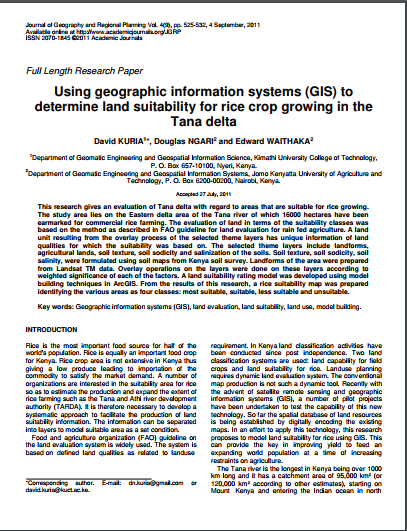
Topics and Regions
Vision
To be a centre of excellence in promoting the Formulation and application of appropriate land and natural resource policies, laws and management practices by empowering society through innovative and knowledge based advocacy and capacity building in Kenya and the region.
Mission
To contribute to transformation of society through offering a bridge between communities, stakeholders and policy makers in the promotion of equitable access and sustainable management of land and natural resources.
Goal
To contribute to the transformation of society and empowerment of the citizens through influencing, promotion and advancement of policies, procedures and tools necessary for the equitable access and sustainable management of land and natural resources.
Details
Public Email
Location
Contributions
Displaying 11 - 20 of 78Using parallel random forest classifier in predicting land suitability for crop production
In this paper, we present an optimized Machine Learning (ML) algorithm for predicting land suitability for crop (sorghum) production, given soil properties information. We set-up experiments using Parallel Random Forest (PRF), Linear Regression (LR), Linear Discriminant Analysis (LDA), KNN, Gaussian Naïve Bayesian (GNB) and Support Vector Machine (SVM). Experiments were evaluated using 10 cross fold validation. We observed that, parallel random forest had a better accuracy of 0.96 and time of execution of 1.7 sec. Agriculture is the main stream of food security.
ASSESSMENT OF LAND USE LAND COVER CHANGE AND DECLINE IN SUGARCANE FARMING USING GIS AND REMOTE SENSING - A CASE STUDY OF MUMIAS DISTRICT, KENYA
Land use/cover changes are pervasive with no clear understanding of their spatial extends, drivers and impacts to society. Land-use changes have become a key component in the current strategies for managing and monitoring the natural resources and environment changes. The purpose of this study was to assess the land covers change and decline in sugarcane farming using a three time series of Landsat satellite images of 1984, 2000 and 2015.
Remote Sensing-based Evaluation of Trends and Impacts of Land Surface Property Changes in the Mara Ecosystem in Kenya
The Earth’s land surface is a key component of its climate system. Terrestrial plants, animals and human beings rely on the land surface for sustenance and existence; as such, its prevailing conditions and properties are essential to terrestrial life. Because land cover is a major component of the land surface, its alteration constitutes a form of land surface change.
Land Suitability Assessment For Effective Crop Production, a Case Study of Taita Hills, Kenya
Agriculture is the backbone of Kenya’s economy. Agriculture in Kenya is characterized by low productivity due to low external inputs, lack of good farming practices, soil erosion, and other losses. In most farming regions of the country, agriculture depends entirely on rainfall which sometimes is scarce. The problem of selecting the correct land for the cultivation of certain crops is a long-standing and mainly empirical issue. The objective of this study is to extrapolate and generate a crop suitability map showing areas suitable for agricultural activities in Taita Hills in Kenya.
Using geographic information systems (GIS) to determine land suitability for rice crop growing in the Tana delta
This research gives an evaluation of Tana delta with regard to areas that are suitable for rice growing. The study area lies on the Eastern delta area of the Tana river of which 16000 hectares have been earmarked for commercial rice farming. The evaluation of land in terms of the suitability classes was based on the method as described in FAO guideline for land evaluation for rain fed agriculture. A land unit resulting from the overlay process of the selected theme layers has unique information of land qualities for which the suitability was based on.
STRATEGIES TO MODERNIZE THE LAND REGISTRATION SYSTEM IN KENYA
The land registration system in Kenya was established in 1897 to support land registration for white settlers who had come into the country during the 19th Century. In the last one hundred years that the system has been in existence it has remained relatively the same; registry records are kept in paper format and the majority of operations are carried out on manual basis. This lack of a modern registration system has contributed to problems in land administration in the country.
AN ASSESSMENT OF THE PERFORMANCE OF THE ENVIRONMENT AND LAND COURT
Dispute resolution is a key component of land administration and management in Kenya. Article 162 of the Constitution of Kenya provides for the establishment of the Environment and Land Court (ELC) by an Act of Parliament. Further, parliament is mandated to determine the jurisdiction and functions of the courts. In 2011, parliament passed the Environment and Land Court Act through which the Environment and Land Court was established. In accordance with the provisions of this act, the court is mandated to ensure reasonable and equitable access to its services in all counties.
KNOW YOUR LAND RIGHTS
The promulgation of the Kenyan Constitution 2010 brought into place concerns about the urgency for land reform. Land reforms hold the key to solving some of Kenya’s greatest challenges such as landlessness, community cohesion, food security and sustainable development. Land reforms lie at the heart of the work of the National Land Commission (NLC) and Kituo cha Sheria and they are also at the heart of many Kenyan communities who live, work and rely on land. Information contained in the book goes a long way in educating these communities about their land rights.
Land Politics under Kenya's New Constitution
Kenya's new constitution, inaugurated in August 2010, altered the institutional structure of the state in complex ways. The general motivation behind reform was to enhance the political representation of ordinary citizens in general and that of marginalized ethno-regional groups in particular, and to devolve control over resources to the county level. In the land domain, reform objectives were as explicit and hard-hitting as they were anywhere else.










